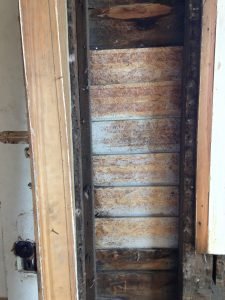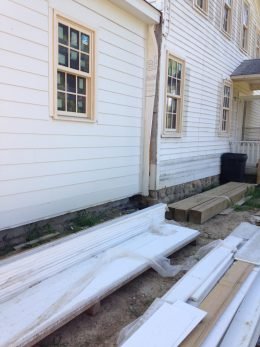Installment 9: The Siding Story

One of their next tasks during the restoration is to clean, restore, and paint the exterior. For most of the building, this will be a straightforward scrape and paint job. Workers will also check the 150+ year old clapboard for soft spots that may need to be replaced… a constant task on a building of any age! In fact, shortly after the building was moved in 2010, deteriorated courses of siding above the sill were replaced. Later, when Cedroni workers opened portions of the interior to install new wiring, we found places where clapboard had been replaced in the 1950s or 60s.

In the mid-1980s a new siding material called Hardie Board was developed using a formula of cement, sand, and cellulose fibers. This siding is a color-fast fast, termite proof and water resistant. More recently, AZEK siding was developed from recycled PVC materials. It is light-weight, moisture resistant, and wood-like in appearance. Both materials are approved as durable exterior materials in historic restoration projects because they look like clapboard.

The siding on the new northwest addition is Hardie Board. The planks are intentionally larger than the original clapboard. This follows the Preservation Standard for Rehabilitation, which states, “The new work shall be differentiated from the old and shall be compatible with the massing, size, scale, and architectural features…”
To learn more about the history of clapboard click here:
http://www.colonialsense.com/How-To_Guides/Restoration/Clapboard_Siding.php.
The article includes a great illustration by Eric Sloane that shows how logs were cut into clapboard.